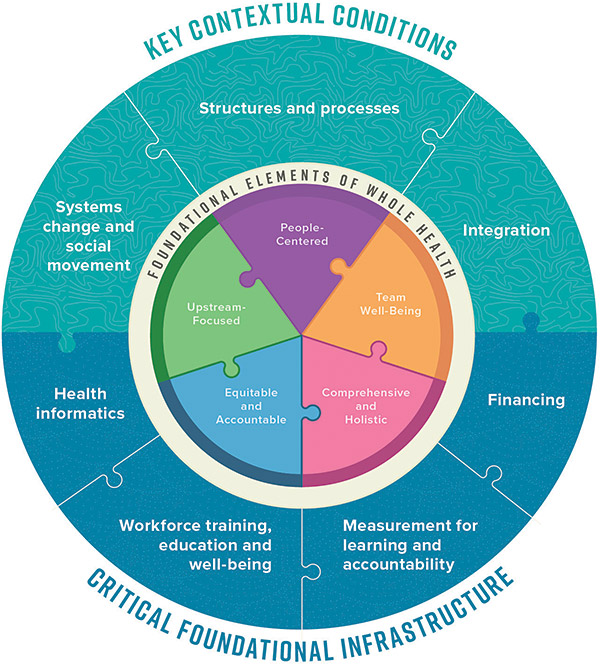Whether you accept it, avoid it or live somewhere in between, insurance coverage has become a defining issue for our profession. Patients increasingly expect to use their benefits, practitioners want to be compensated fairly for their time and expertise, and the system itself remains – at best – fragmented. The encouraging news is that coverage has expanded in meaningful ways. The challenging news is that reimbursement, across the board, remains inadequate.
Redefining National Well-Being: NASEM's Bold Vision for Comprehensive Health
- The framework of the new report emphasizes holistic well-being, personalized care, and the integration of physical, mental, emotional, and social components of health.
- The report advocates for a shift from conventional disease-centered care to a patient-centered, team-based approach that strives to achieve well-being by putting the patient’s goals first.
- However, regulatory constraints, limited insurance coverage and varying state-level policies can impede the widespread adoption of these practices.
The National Academies of Science, Engineering and Medicine (NASEM) recently released a 406-page report titled “Achieving Whole Health: A New Approach for Veterans and the Nation,” presenting an innovative framework that could, if implemented, transform the landscape of health care.
This framework emphasizes holistic well-being, personalized care, and the integration of physical, mental, emotional, and social components of health. While the report’s focus is primarily on veterans, its principles have implications that extend to the broader realm of public health.
Prioritizing Whole Health
The report defines whole health as encompassing “physical, behavioral, spiritual, and socioeconomic well-being as defined by individuals, families, and communities.” Dr. Ben Kligler, executive director of the Office of Patient Centered Care & Cultural Transformation at the Department of Veterans Affairs (VA), passionately advocated for the whole-health framework during an Integrative Health Policy Consortium (IHPC) congressional briefing I attended.
His vision is for this framework to become a model for the future of the entire U.S. health care system. Our current medical model, while indispensable for acute care, often falls short in addressing the comprehensive needs of individuals seeking long-term health and vitality.
The report’s opening paragraph serves as an accurate reflection of our nation’s current state of (ill) health and the shortcomings of our existing health care model:
“Healthcare in the United States is at a critical crossroads. Life expectancy has been decreasing for nearly a decade. Complications from multiple chronic conditions continue to rise. Mental health needs are at an all-time high. Unhealthy behaviors are prevalent. Despite remarkable breakthroughs and innovations in treating disease, the United States has worse health outcomes than most other developed countries and at a substantially higher cost. Adding fuel to the fire, the COVID-19 pandemic has killed millions of people worldwide; caused physical, mental, and social suffering; and exacerbated health and economic inequities.”
Foundational Elements
The report advocates for a shift from conventional disease-centered care to a patient-centered, team-based approach that strives to achieve well-being by putting the patient’s goals first. It acknowledges that health is a multifaceted state influenced by a complex interplay of factors. The foundational elements of achieving whole health encompass:
Personalized Care: The report stresses the importance of tailoring health care to individual needs and preferences. This acknowledges that each person’s health journey is distinct, warranting treatments aligned with their specific circumstances and values.
Holistic Well-Being: NASEM’s initiative encourages the integration of physical, mental, emotional, and social well-being. This holistic perspective acknowledges the intricate connections among various dimensions of health, promoting comprehensive care that transcends the typical fragmented approach.
Patient Empowerment: The recommended framework empowers patients to play an active role in their health care decisions. It fosters open communication between patients and health care providers, nurturing collaborative partnerships that yield improved health outcomes by orienting a person toward their goals. An individual is more likely to achieve their health care goals when they are empowered to take charge of their life and health.
Preventive Strategies: The report underscores the significance of health promotion and disease prevention. By addressing root causes and risk factors, rather than solely managing symptoms, a whole-health approach aims to reduce the incidence of illnesses and promote long-term well-being.
Integration of Services: The initiative advocates for integrating diverse health care services, encompassing conventional medical interventions, mental health support, complementary therapies, and social services through team-based care. This comprehensive approach ensures all facets of an individual’s health are addressed.
Inclusivity: The report advocates for inclusive health care that addresses the diverse needs of individuals, including those from different cultural, socioeconomic and demographic backgrounds.
Cost Savings: The VA Whole Health System has been shown to reduce overall costs of care. Those veterans who used the Whole Health System had a reduction in expenditures in all service categories (except pharmacy), ranging from 12-24%.
The report also highlights the importance of personalized care, a cornerstone of integrative health approaches. Acknowledging the unique trajectory toward well-being for each individual, integrative health providers adapt interventions to suit patients’ distinctive needs and preferences. This level of customization strengthens the therapeutic alliance and empowers patients to actively engage in their healing journey.
Challenges to Integration
However, the integration of whole-health concepts into mainstream health care is not without its challenges. Regulatory constraints, limited insurance coverage and varying state-level policies can impede the widespread adoption of these practices.
To fully harness the potential of integrative health in advancing the NASEM initiative, concerted efforts are needed to address these challenges, promoting inclusivity and accessibility for all individuals seeking holistic care. This point was driven home in a recent conversation with Dr. Margaret Chesney, professor of medicine at the UCSF School of Medicine, former deputy director of the National Center for Complementary and Integrative Health at NIH, and a member of the NASEM report-writing team.
She emphasized that whole health will require a new coordinated and holistic approach to improving the health of our citizens. This, by necessity, will involve improving the health of the people through, education, public health, community engagement, and health care.
Public-Health Implications
The implications of this report for enhancing overall public health are significant:
Transition From Reactive to Proactive Care: Embracing the whole-health approach shifts health care from a reactive model that focuses solely on treating diseases to a proactive model that prioritizes prevention and overall well-being. This shift could alleviate strain on health care systems by averting the development of chronic illnesses.
Mental Health Integration: The holistic approach acknowledges the intrinsic link between mental and physical health. By prioritizing mental health support and incorporating it into physical health care, the framework can contribute to managing the escalating mental health crisis exacerbated by the ongoing COVID pandemic.
Mitigation of Health Disparities: The personalized and inclusive nature of the framework offers potential to tackle health disparities by tailoring care to the unique requisites of distinct populations. It acknowledges that uniform solutions may not effectively cater to everyone’s needs
Empowerment and Education: Central to the initiative is patient engagement and empowerment. This incentivizes individuals to actively participate in managing their health, fostering improved self-care practices and better health outcomes.
Research and Collaboration: The report’s emphasis on integrating different health care modalities opens the door for collaborative research between conventional medicine and integrative approaches. This collaboration has the potential to fuel innovation, broaden our comprehension of health and enrich treatment options.
Community and Social Support: By addressing social determinants of health and considering the broader social context, the framework can cultivate healthier communities and foster stronger social connections.
Reduced Health Care Costs: Preventive strategies and early interventions may ultimately mitigate health care expenses over time by averting chronic illnesses and complications that frequently necessitate costly treatments.
One specific recommendation particularly caught my attention among the six major goals outlined in the report. Recommendation 6.2. states:
“The Department of Veterans Affairs, in partnership with the Department of Health and Human Services (HHS), should create a national Center for Whole Health Innovation to design and advance the policies and payments for whole health care.”
This is truly where theory is put into practice in U.S. health care. With significant funding and resources at the disposal of HHS, the government could take a substantial stride toward achieving this ambitious goal.
There are quite a few pieces of the puzzle in achieving whole health, from workforce training (which would include interprofessional education) to final integration, all of which must be accomplished to transition to a model of health care that focuses on health promotion and disease prevention. (Figure 1)




